True, one year ahead is when I usually start my important techs... that's a bearable ahead-of-time penalty.alan_le_cowboy said:Its true but it is generally considered that 1 year penalty can be offset by other bonus (blueprints, good tech teams with high score or many tech match).
For example, 1 year ahead gives you an approx. 50% penalty and having field of expertise gives you a 50% bonus.
The Setting Sun - Gotterdammerung, Japan 1944.
- Thread starter unmerged(59906)
- Start date
-
We have updated our Community Code of Conduct. Please read through the new rules for the forum that are an integral part of Paradox Interactive’s User Agreement.
You are using an out of date browser. It may not display this or other websites correctly.
You should upgrade or use an alternative browser.
You should upgrade or use an alternative browser.
UncleAlias - Have to look on the positive side of things 
Edzako, alan_le_cowboy - Correct no nukes except in Doomsday unless I enable it manually, which I won't do.
Juan_de_Marco - The '45 Infantry are Manchurian as I have yet to research that model. Brigades might be useful certainly but I am actually trying as best I can to increase manpower enough to build garrisons as they are badly needed already. Once I start pushing the Red Army back I will need even more or everything will grind to halt due to a massive overload on TC.
Juan_de_Marco, safferli, alan_le_cowboy - I stand corrected and thank you for pointing it out. I guess I am so used to researching a year ahead as Germany I forget there is a penalty. The penalty is largely offset by advances but it is still there and cannot be completely removed even with the last computer tech.
Sokraates - I don't just reply much do I ? With regards to the Soviet losses it is almost impossible to know the totals as I do not count each one my aircraft destroy. I can compare intelligence reports which I will do in the update.
With regards to the Soviet losses it is almost impossible to know the totals as I do not count each one my aircraft destroy. I can compare intelligence reports which I will do in the update.
alan_le_cowboy, Sokraates - Beating up and not destroying enemy troops is against the rules as if it works as you say its a little on the gamey side. I decided to show the Soviet manpower pool in the Intelligence reports. The numbers are from October which is close enough to show the size.
Phax - You are forgiven but I still haven't won

M79, Porkman - Porkman is correct the infrastructure is awful in that region and would give the enemy too much time to react. I might try it as a diversion though at some point.
I will post the annual update in two lots, one now and one tomorrow. The report is growing each year and is closing in on 50 screenshots which is far too many for one update.
Note: Last Years Annual Report is on page 79.
Edzako, alan_le_cowboy - Correct no nukes except in Doomsday unless I enable it manually, which I won't do.
Juan_de_Marco - The '45 Infantry are Manchurian as I have yet to research that model. Brigades might be useful certainly but I am actually trying as best I can to increase manpower enough to build garrisons as they are badly needed already. Once I start pushing the Red Army back I will need even more or everything will grind to halt due to a massive overload on TC.
Juan_de_Marco, safferli, alan_le_cowboy - I stand corrected and thank you for pointing it out. I guess I am so used to researching a year ahead as Germany I forget there is a penalty. The penalty is largely offset by advances but it is still there and cannot be completely removed even with the last computer tech.
Sokraates - I don't just reply much do I ?
alan_le_cowboy, Sokraates - Beating up and not destroying enemy troops is against the rules as if it works as you say its a little on the gamey side. I decided to show the Soviet manpower pool in the Intelligence reports. The numbers are from October which is close enough to show the size.
Phax - You are forgiven but I still haven't won
M79, Porkman - Porkman is correct the infrastructure is awful in that region and would give the enemy too much time to react. I might try it as a diversion though at some point.
I will post the annual update in two lots, one now and one tomorrow. The report is growing each year and is closing in on 50 screenshots which is far too many for one update.
Note: Last Years Annual Report is on page 79.
Last edited:
Update (January 1st 1947)
0000 January 1st 1947.
Imperial Palace. Tokyo, Japan.
"Good morning your Majesty, Gentlemen. The last year has been a very busy time for Japan with gains in the Pacific placing us in almost complete control of the area. War with the Soviet Union began in April when they crossed our borders. Our Imperial forces have held their ground against the odds and losses have been minimal. Reports for this meeting are to be more detailed as it is the beginning of a New Year." Hideki began the meeting.
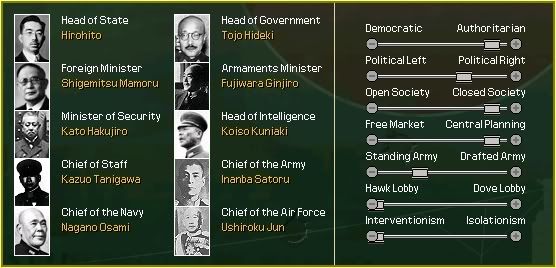
"There have been no changes to the Cabinet over the last twelve months as you are all aware. You have performed admirably and there is no reason to alter the current structure for the forseeable future. Reports will begin with the usually quiet Security report." concluded Hideki.
"Good morning your Majesty, Gentlemen." Hakujiro began. "The Security situation had altered quite a lot during the last twelve months with partisan activity prevalant in two main areas."
"Good morning your Majesty, Gentlemen." Hakujiro began. "The Security situation had altered quite a lot during the last twelve months with partisan activity prevalant in two main areas."
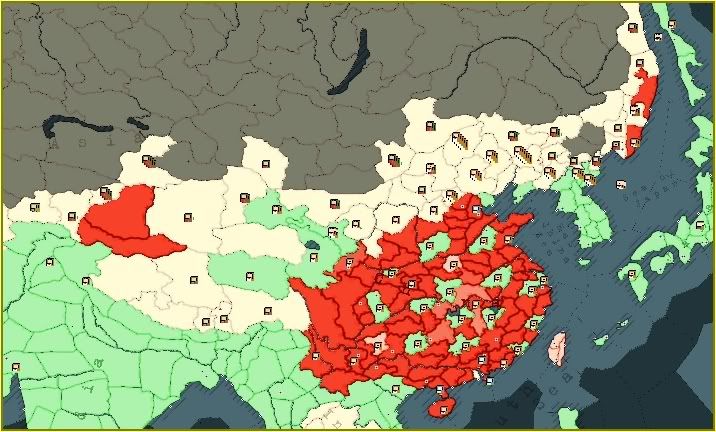
"Asia is still a hotbed of activity but overall the troubles have reduced by some margin as we have passed on the peace keeping duties to the Red Army in Sinkiang. China continues to provide unrest but it is under control and there have been no outbreaks of open hostility for some time. Further territorial changes are likely to reduce our problems in this entire area as we allow the Red Army to advance."
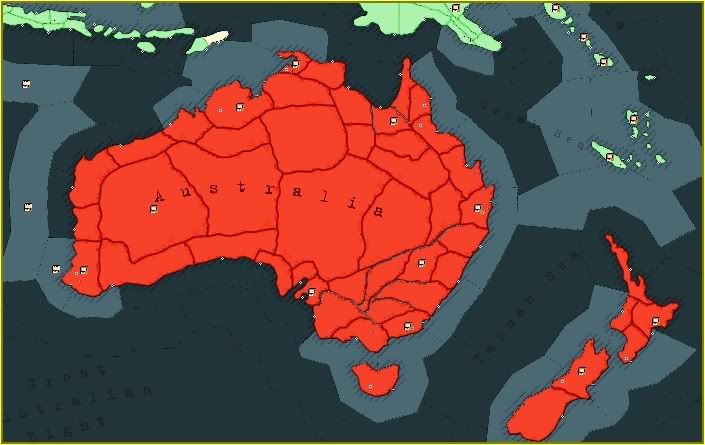
"A much larger problem is that of Australia and New Zealand. We have no garrison divisions at all in these two Countries which leads to high levels of unrest. We currently have eleven Infantry divisions covering both Countries to quickly quell any unprisings, of which there have been none to date. We could free up these Infantry for other operations if they were replaced by more suitable troops for the job but I understand that our manpower is severely limited and this will not be happening any time soon. Nothing more from me." concluded Hakujiro.
"Diplomacy please."
"Your Majesty, Gentlemen, good morning. Trade with many Countries continues and is slowly increasing where possible as we have covered before with the only major loss during the last year being all of our trades with the Soviet Union. I shall round up the current situation with regards to the Major Alliances." Mamoru began.
"Diplomacy please."
"Your Majesty, Gentlemen, good morning. Trade with many Countries continues and is slowly increasing where possible as we have covered before with the only major loss during the last year being all of our trades with the Soviet Union. I shall round up the current situation with regards to the Major Alliances." Mamoru began.
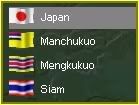
"Firstly the Axis, or what is left of it. No changes to last year with just us and our puppet States against most of the World."
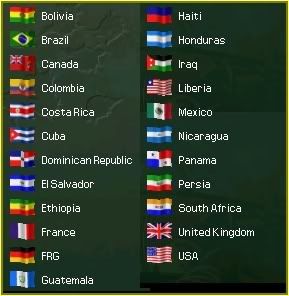
"The Allies have been reduced by two Countries due to our efforts in the Pacific. Australia and New Zealand are no longer concerned with War at all and were forced to leave their former Allies by our Armed Forces. No new Countries have joined their cause. The vast majority of these Nations are small or medium sized and are centered around America and the Carribean. The United States and the United Kingdom are the two largest member States."
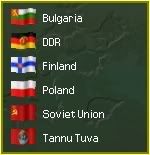
"The Comintern still possesses six Nations in its Alliance. There have been two changes with Tannu Tuva joining and Mongolia leaving due to our conquest of the Country. This change slightly weakens this Alliance where the Soviets are by far the largest Country. Nothing more from me today." concluded Mamoru.
"Intelligence next please."
"Good morning your Majesty, Gentlemen." Kuniaki began. "In similar fashion to last year I will compare intelligence reports from a year ago with todays estimates."
"Intelligence next please."
"Good morning your Majesty, Gentlemen." Kuniaki began. "In similar fashion to last year I will compare intelligence reports from a year ago with todays estimates."
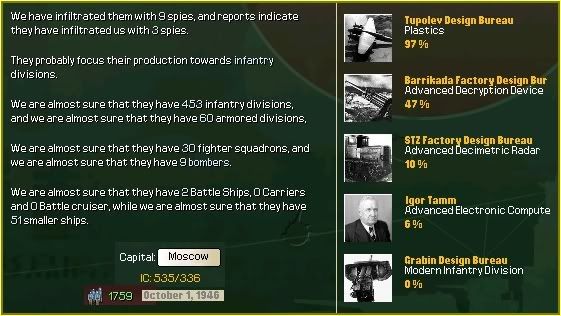
"Last year we had good relations with the Soviet Union and that changed in April with the outbreak of War. Their industrial capacity has increased by eight factory complexes in twelve months all due to conquest. This is a relatively minor amount over that course of time. We do not think they suffer any material shortages with the exception of sporadic supply problems.
The Red Army had 519 Infantry and 69 Armoured divisions last year and this peaked at around 550 Infantry divisions prior to the outbreak of hostilities. The current estimates of the Red Army show a loss of roughly 100 Infantry divisions from the peak and nine Armoured. The losses for them have been higher as they continue to raise new troops but the trend is a decline that is increasing over time. We are probably pretty close to destroying the equivalent of our own forces in Asia and yet they still outnumber us three to one.
I did find one report from one of my operatives in the Soviet Union that provided a rough number for their manpower reserves. The report was from October, and I have no supporting evidence to say how accurate it may be, but according to my source the Red Army can still muster an Army from its reserves that is of a size comparable to our own. The large reserve leads me to conclude that no major force build is or has been under way by the Soviets since War broke out. I can only say that they seem to think they already have enough troops to do what they wish to do.
The numbers for the Airforce and Navy are almost totally unchanged even though we have captured aircraft and sunk some Submarines. They are clearly building both ships and planes to keep the numbers even."
The Red Army had 519 Infantry and 69 Armoured divisions last year and this peaked at around 550 Infantry divisions prior to the outbreak of hostilities. The current estimates of the Red Army show a loss of roughly 100 Infantry divisions from the peak and nine Armoured. The losses for them have been higher as they continue to raise new troops but the trend is a decline that is increasing over time. We are probably pretty close to destroying the equivalent of our own forces in Asia and yet they still outnumber us three to one.
I did find one report from one of my operatives in the Soviet Union that provided a rough number for their manpower reserves. The report was from October, and I have no supporting evidence to say how accurate it may be, but according to my source the Red Army can still muster an Army from its reserves that is of a size comparable to our own. The large reserve leads me to conclude that no major force build is or has been under way by the Soviets since War broke out. I can only say that they seem to think they already have enough troops to do what they wish to do.
The numbers for the Airforce and Navy are almost totally unchanged even though we have captured aircraft and sunk some Submarines. They are clearly building both ships and planes to keep the numbers even."
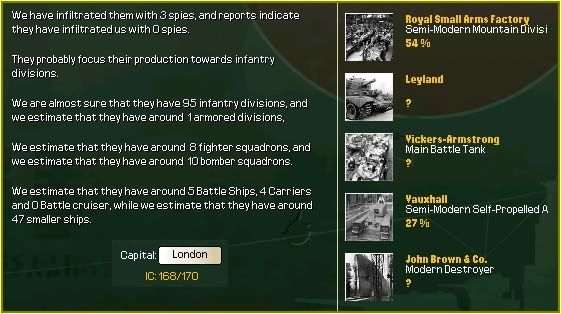
"The United Kingdom have seen their factory numbers increase by two due to the capture of Yemen and Oman. They can not use most of it a lot of the time as they are still short of Rare materials and look likely to remain so.
Their Armed Forces have seen next to no change at all with only minor differences visible which can all be accounted for by inaccuracies in reports from my limited number of agents. The vast majority of their ground forces are thought to be lent troops from Allied Nations and not native which means they are of varying quality most of the time. Losses in India are keeping this number under control for the time being."
Their Armed Forces have seen next to no change at all with only minor differences visible which can all be accounted for by inaccuracies in reports from my limited number of agents. The vast majority of their ground forces are thought to be lent troops from Allied Nations and not native which means they are of varying quality most of the time. Losses in India are keeping this number under control for the time being."
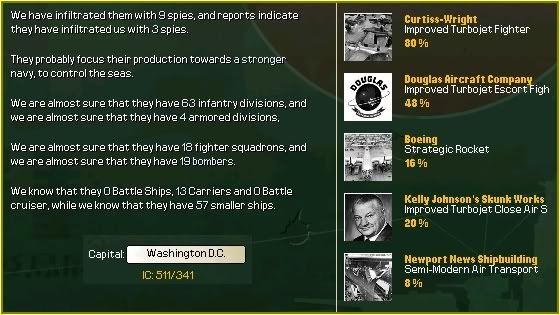
"The United States has not had a good year. Their factory output is unchanged and they have, nor are likely to have, any material shortfalls.
Their Armed Forces have been mauled. They have lost approximately 15% of their ground troops mostly onboard Transport fleets.
Their Airforce numbers indicate massive losses with the numbers close to being two thirds if they are correct. This would be entirely due to aircraft destroyed on the ground during our advance through the Pacific.
The United States Navy had already been decimated by this time last year but it has still suffered large losses. Both of its Battleships were sunk as well as nearly half of its smaller vessels. Carrier numbers remain the same which means that we probably sank somewhere in the region of 10 - 12 of them if we allow for one build a month."
Their Armed Forces have been mauled. They have lost approximately 15% of their ground troops mostly onboard Transport fleets.
Their Airforce numbers indicate massive losses with the numbers close to being two thirds if they are correct. This would be entirely due to aircraft destroyed on the ground during our advance through the Pacific.
The United States Navy had already been decimated by this time last year but it has still suffered large losses. Both of its Battleships were sunk as well as nearly half of its smaller vessels. Carrier numbers remain the same which means that we probably sank somewhere in the region of 10 - 12 of them if we allow for one build a month."
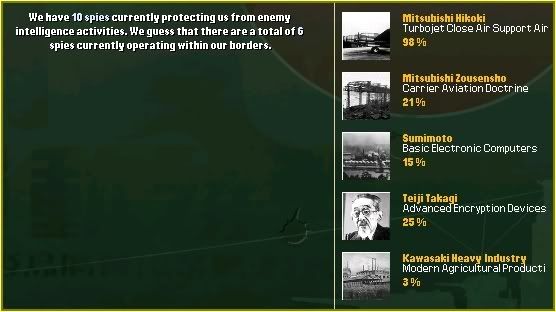
"The number of enemy spies in our Nation has dropped by one which we captured during an attempted spying mission against us. Most of the remaining spies are Soviet. Our research should finish into another upgrade to our Dive bombers shortly, with nothing else due for several months at the earliest. I will go into more detail about our current research situation."
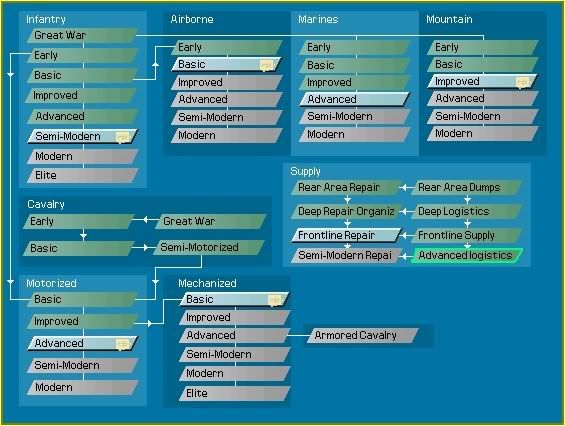
"Infantry research has seen one improvement over last year with better Logistics as a result. I am planing to improve our Infantry when possible to counter advances by our enemies."
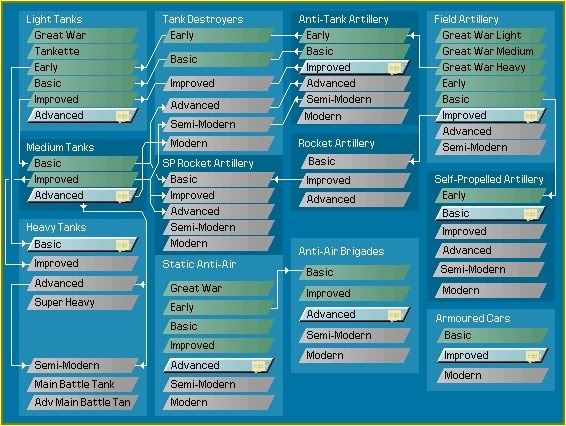
"In similar fashion to last year there have been changes to our Armour research."
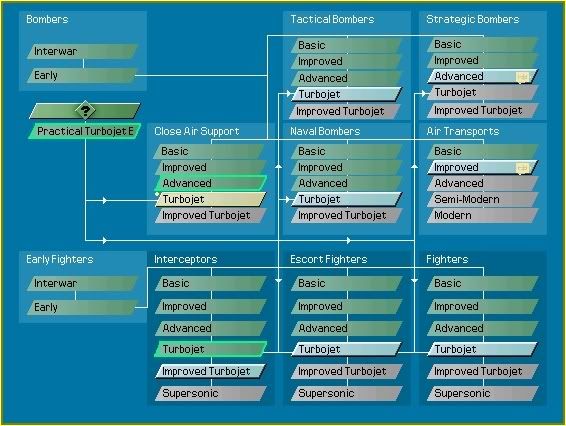
"Airforce research has been moving along pretty well with quite a few changes. The discovery of Turbojet engines led to an improved Interceptor with a third project completing to upgrade our Dive bombers."
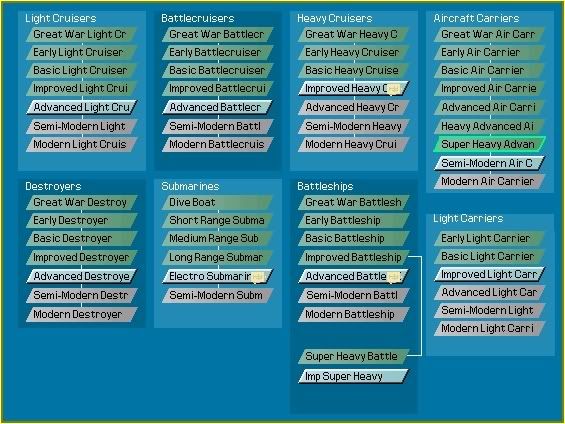
"One improvement in Naval research led to a better class of Aircraft Carrier with no further plans to research more in this area for the time being."
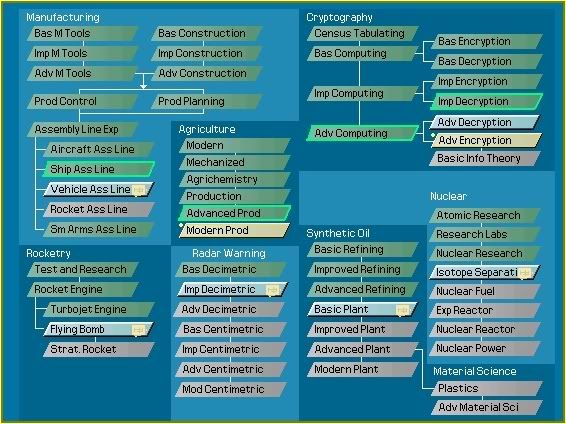
"Industry saw the largest number of completed projects. Four in all ranging from improved Ship Building to Agricultural techniques and Computers."
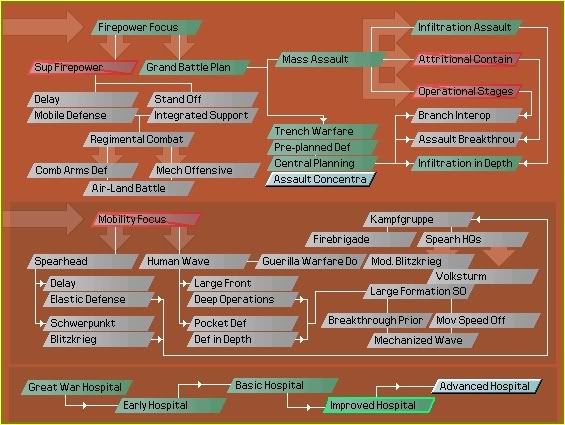
"One change to Land Doctrine with a better Hospital system to reduce casualties and help maintain our manpower reserves."
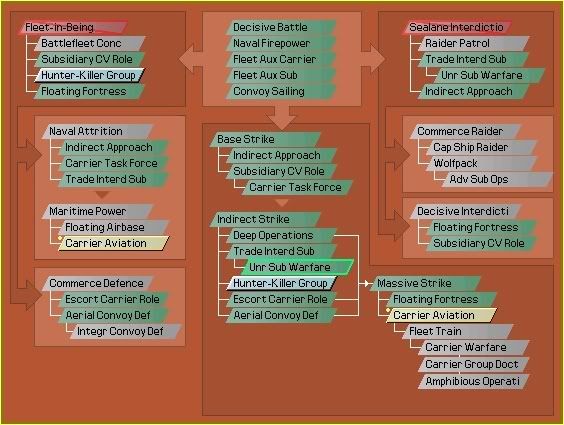
"Unrestricted Submarine Warfare was the only change to Naval Doctrines with the loss of Yamamoto slowing down any further research."
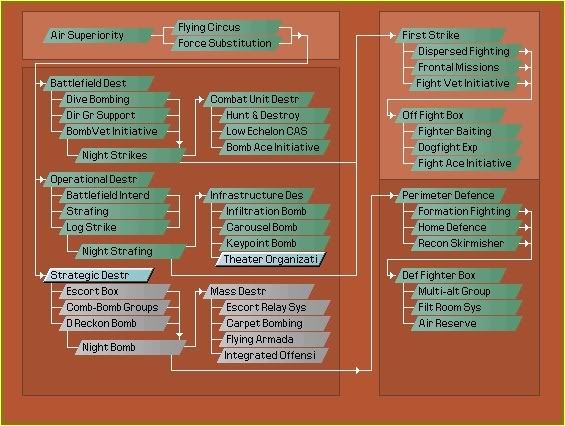
"No change to Air Doctrines and this will remain so."

"Secret research has seen no gains although we are looking into better computers at this time."
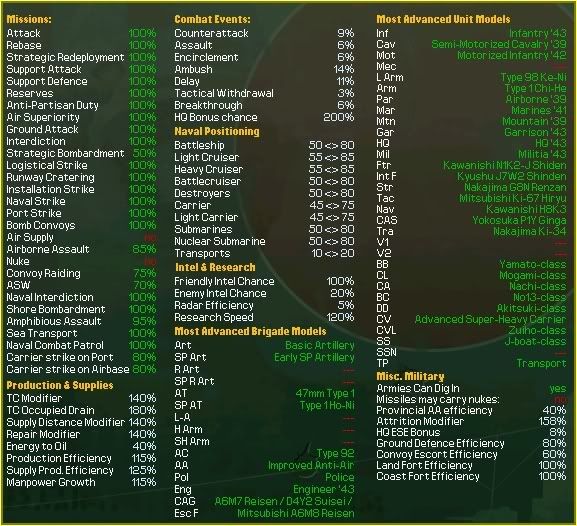
"Just for added information this last report shows our current progress across all areas including the models of our latest Armed Forces variants. Eleven research projects were completed during 1946. Nothing more from me." concluded Kuniaki.
"We shall have a short break before finishing the remaining reports for you Gentlemen to stretch your legs." stated Hideki.
"We shall have a short break before finishing the remaining reports for you Gentlemen to stretch your legs." stated Hideki.
Losing around 100 divisions is much, even for the Soviet Union. However, these losses would be around 11 per month, which the Soviet Union could reproduce theoretically.
Though that would probably drain their MP rather quickly. Also the Rate of destruction increases, the closes the enemy gets to your airbases.
All in all it doesn't look good for the Soviet Union.
And I've finally realized, whom Tanigawa resembles to: Grendel!
Here's the proof:
The spawn of Cain is guiding Japan's armies! No wonder they are so successful.
Though that would probably drain their MP rather quickly. Also the Rate of destruction increases, the closes the enemy gets to your airbases.
All in all it doesn't look good for the Soviet Union.
And I've finally realized, whom Tanigawa resembles to: Grendel!
Here's the proof:
The spawn of Cain is guiding Japan's armies! No wonder they are so successful.
Sokraates said:And I've finally realized, whom Tanigawa resembles to: Grendel!
Here's the proof:
The spawn of Cain is guiding Japan's armies! No wonder they are so successful.
I guess I can see the resemblance. I mean, they are both hard to make out.
100 divisions? hmm, if i tried that with my Aircraft, i would have lost 30 bombers.... 
that is due to the game being played is DD 1.3 not arma 1.2( which introduced reduction of partisan activity over time)Maj. von Mauser said:Nice yearly update.
Didn't imagine partisans would still be so active in China.
robou said:100 divisions? hmm, if i tried that with my Aircraft, i would have lost 30 bombers....
That is due to the game being played is DD 1.3 not arma 1.2( which introduced heavy losses on aircraft on ground attack missions)
...heh
al_faris said:that is due to the game being played is DD 1.3 not arma 1.2( which introduced reduction of partisan activity over time)
And also due to higher difficulty level.
Velko said:That is due to the game being played is DD 1.3 not arma 1.2( which introduced heavy losses on aircraft on ground attack missions)
...heh
yeah, i know
I think Arma fixed a few flaws... Now USA will actually try to defend their homeland once its clear Europe is a lost cause.
And reducing the invulnerability on planes is a good thing, imho.
And reducing the invulnerability on planes is a good thing, imho.
Argus Eritarami said:I think Arma fixed a few flaws... Now USA will actually try to defend their homeland once its clear Europe is a lost cause.
And reducing the invulnerability on planes is a good thing, imho.
Not to speak of the revoltrisk reduction in occupied provinces and annexed countries since v. 1.2.
Murmurandus - They keep people informed 
Sokraates - 100 is a good start considering my airforce was old when war broke out. Damage is increasing and will continue to do so once the snows melt and the weather improves.
robou, al_faris, Maj. von Mauser, Velko, cosminus, Argus Eritarami, trekaddict - I don't have Arma myself so can't directly compare but the list is fairly well documented. Air power greatly reduced makes a large difference but Arma has some good things as well as have been mentioned.
Second part of the Annual report to follow, a little later than advertised, with all the numbers you guys love as well as a look back at the end of June for the enemy Navies ...
Sokraates - 100 is a good start considering my airforce was old when war broke out. Damage is increasing and will continue to do so once the snows melt and the weather improves.
robou, al_faris, Maj. von Mauser, Velko, cosminus, Argus Eritarami, trekaddict - I don't have Arma myself so can't directly compare but the list is fairly well documented. Air power greatly reduced makes a large difference but Arma has some good things as well as have been mentioned.
Second part of the Annual report to follow, a little later than advertised, with all the numbers you guys love as well as a look back at the end of June for the enemy Navies ...
Update (January 1st 1947)
Part II
Part II
0000 January 2st 1947.
Imperial Palace. Tokyo, Japan.
"Welcome back Gentlemen." HIdeki greeted the Cabinet as it returned to the meeting. "Industry is the next."
"Good morning your Majesty, Gentlemen. Considering the changes due to old and new conflicts during the last twelve months our Industry has remained pretty stable largely due to captured enemy stockpiles in both Australia and New Zealand." Ginjiro began.
"Good morning your Majesty, Gentlemen. Considering the changes due to old and new conflicts during the last twelve months our Industry has remained pretty stable largely due to captured enemy stockpiles in both Australia and New Zealand." Ginjiro began.
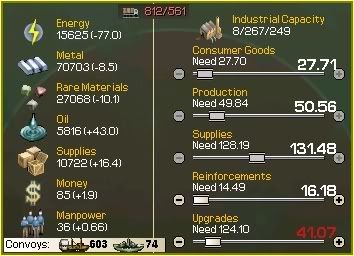
"Our base factory output has increased by ten factory complexes, all from Australia and New Zealand. Transport Capacity is considerably worse largely due to the already mentioned conquests and the partisan activity we acquired as a result. I do not see the situation improving much no matter what we do but I shall try and keep it as under control as possible without additonal garrison forces.
Stockpiles are not critical in any areas with Energy being the primary concern. Our stockpile is roughly the same as last year at this time. Rare Materials have more than doubled with Metal also gaining a fairly large addition. Our current Supply stockpile is similar to last year with our Oil reserves being roughly half. This time last year our primary trading partner was the Soviet Union and it has taken some considerable effort to balance our raw materials since April.
Available manpower has halved during the last twelve months but is up from its low point a few months ago and should hopefully rise some more before hostilities commence in earnest in Asia in the Spring.
Our convoys are adequate but more may be needed soon as we are very slowly losing some to attrition from enemy bombers.
Reinforcements are small and mostly for air and naval forces with our upgrade situation vastly improved from last year. Most of the Interceptor upgrades should complete fairly shortly which will then allow me to move on to the Dive bombers once that research is completed.
Our current production is as follows :
4 x Fighter Escort - Next due January 7th 1947.
2 x Light Carrier - Next due January 17th 1947.
2 x Battlecruiser - Next due August 7th 1947.
2 x Aircraft Carriers - Next due march 15th 1948.
Fairly small in numbers but our production costs are also more or less the same as last year. All of this production is for multiple runs and none will be completed for some years to come. I will also have to try and find some factory output for new Tactical bombers once that research completes later in the year. Done." concluded Ginjiro.
"Armed Forces please."
"Your Majesty, Gentlemen, good morning." Tanigawa began. "I shall give a briefing on the current state of affairs with regards to combat and then hand you over to the respective Armed Forces Ministers for a detailed briefing on their respective spheres."
Stockpiles are not critical in any areas with Energy being the primary concern. Our stockpile is roughly the same as last year at this time. Rare Materials have more than doubled with Metal also gaining a fairly large addition. Our current Supply stockpile is similar to last year with our Oil reserves being roughly half. This time last year our primary trading partner was the Soviet Union and it has taken some considerable effort to balance our raw materials since April.
Available manpower has halved during the last twelve months but is up from its low point a few months ago and should hopefully rise some more before hostilities commence in earnest in Asia in the Spring.
Our convoys are adequate but more may be needed soon as we are very slowly losing some to attrition from enemy bombers.
Reinforcements are small and mostly for air and naval forces with our upgrade situation vastly improved from last year. Most of the Interceptor upgrades should complete fairly shortly which will then allow me to move on to the Dive bombers once that research is completed.
Our current production is as follows :
4 x Fighter Escort - Next due January 7th 1947.
2 x Light Carrier - Next due January 17th 1947.
2 x Battlecruiser - Next due August 7th 1947.
2 x Aircraft Carriers - Next due march 15th 1948.
Fairly small in numbers but our production costs are also more or less the same as last year. All of this production is for multiple runs and none will be completed for some years to come. I will also have to try and find some factory output for new Tactical bombers once that research completes later in the year. Done." concluded Ginjiro.
"Armed Forces please."
"Your Majesty, Gentlemen, good morning." Tanigawa began. "I shall give a briefing on the current state of affairs with regards to combat and then hand you over to the respective Armed Forces Ministers for a detailed briefing on their respective spheres."
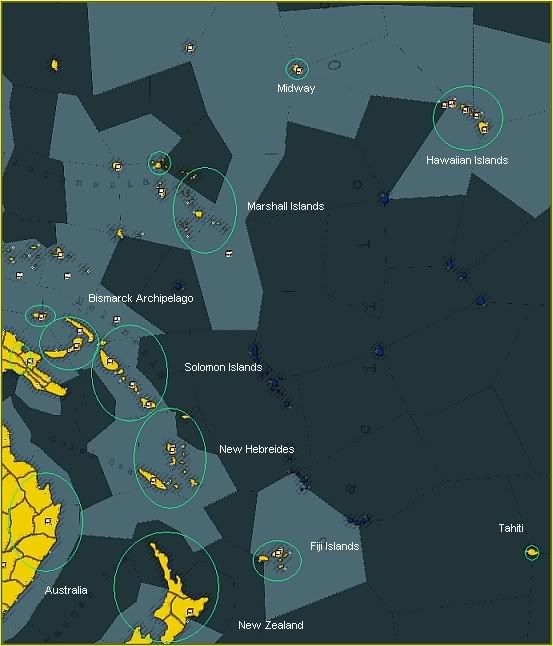
"I shall begin with the Pacific where we made substantial gains during 1946. Both Australia and New Zealand fell to our forces during the year as well as all of the island chains shown on the map. Hawaii is, of course, the most notable of these and no attempt has been made by our enemies to reclaim these islands. Advances are not planned during the coming year as our attention is centered on Asia and the Middle East where the larger threats are at this time. The Allied Navies have not shown much willingness to fight for the Pacific after the mauling they received towards the end of 1945 and during 1946."
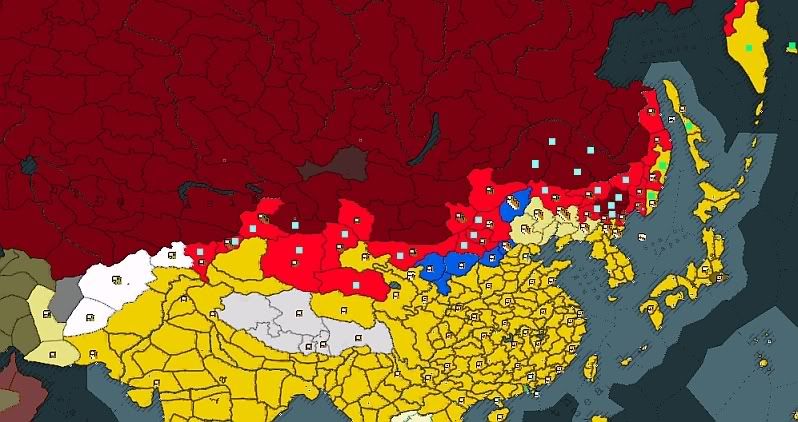
"After eight months of fighting in Asia against the largest Armed force in the World the situation looks like this. The light blue squares are territories we have allowed the Soviets to control with the small amount of green squares showing our gains, which are all in the north east and have been made by amphibious assault. You could almost say that nothing has been achieved of much consequence since the Red Army was unleashed upon us. That would discount the large amount of troops we have killed with our own losses numbering a total of zero divisions. I shall break down the areas in Asia to show more detail."
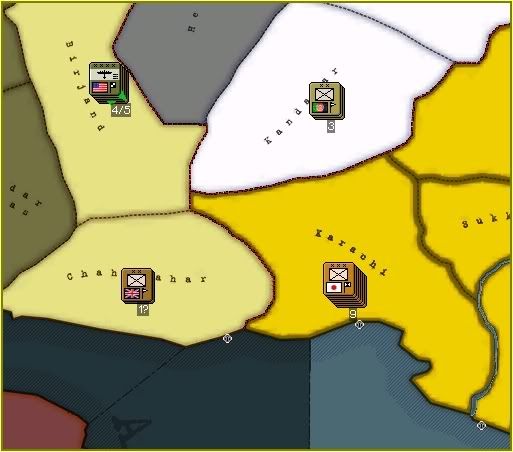
"India sees absolutely no territorial change with us still holding Karachi after some fighting during the year. Forces are currently building up in this area in conjunction with Operation Komodo which is awaiting some reconnaisance before we decide to move forward or just hold our current position. We do have a much larger force guarding Karachi now than at any time previously making it pretty secure."
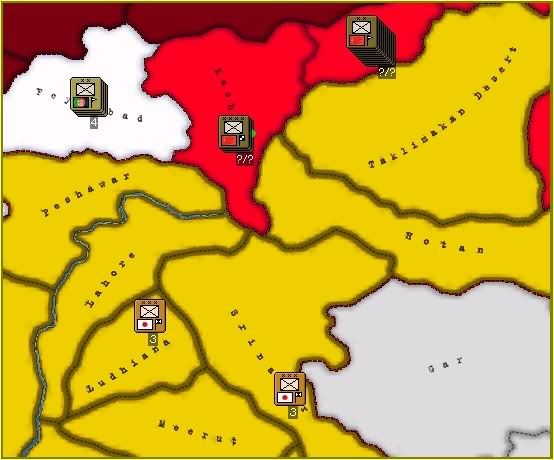
"Further north the Soviets have made no major move to penetrate into northern India from Sinkiang but they did launch a probing attack against Lahore which was repulsed. There are some signs of Soviet build up all along the western front which could prove to be somewhat troublesome come Spring."
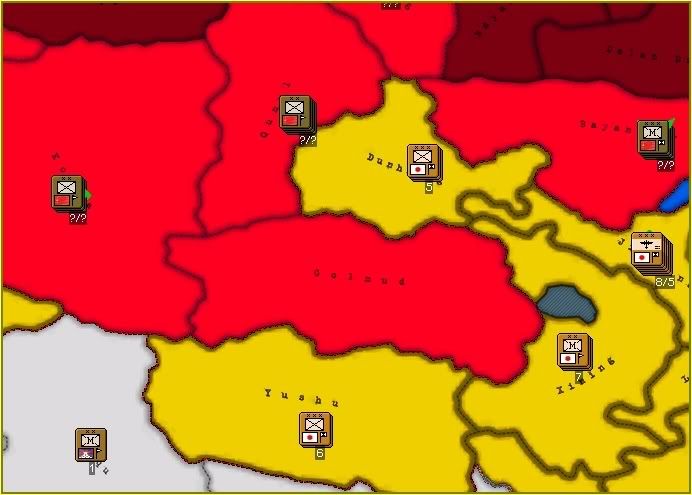
"North eastern China is well defended by our forces for the time being with no major enemy build up so far. Soviet forces are growing in numbers in this region as well as to the west."
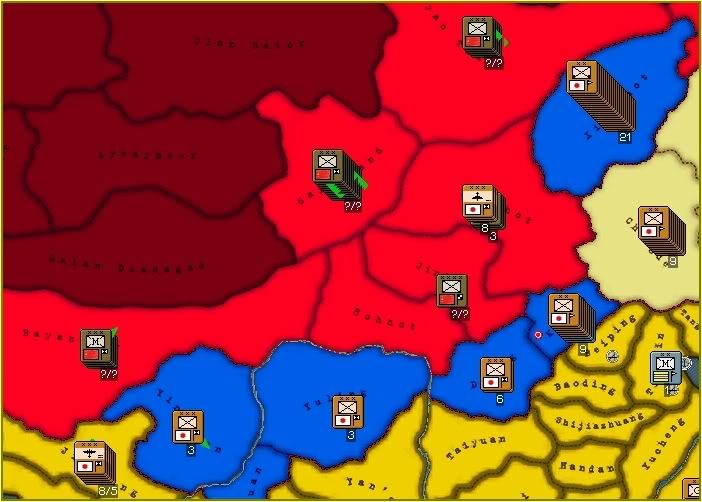
"Mengkokuo is probably our weakest defended area over all and there are Soviet troops heading into this area from the north as shown. We do not know the exact numbers but they certainly outnumber our own by some margin. The threat in this area will not be fully realised until the snows melt as the enemy is reluctant to attack at this time. We did reinforce Kalgan, the capital, with troops from Manchukuo which are of better quality than the local forces. This should provide enough defence to hold this province as a last resort to keep Mengkokuo as a puppet state."
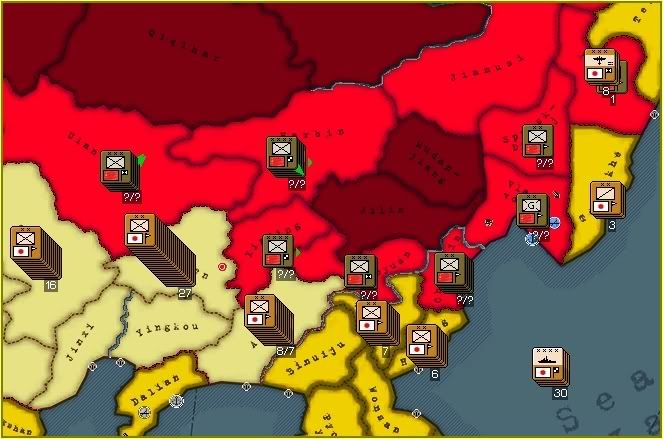
"Manchuria has seen the bulk of all of the fighting so far with fairly large forces involved on both sides. Winter is keeping the Soviets at bay and we do not know exactly what forces are in this area or heading towards it. What we do know is that the enemy forces are significantly weaker in this area than they were when the War started. Our Airforce has been doing a very good job of reducing the numbers against us but I still think the Red Army has superior strength of arms here.
Mulitple invasions along the Siberian coast during Operation Tedious have undoubtedly helped the situation as they have drawn off valuable enemy forces form the front lines. These operations will continue on an opportunity basis to keep the Soviets off guard. We are waiting for the Spring, as no doubt are our enemies, to see what the new Years campaigning season will bring.
I will hand you over to Minister Satoru for a briefing on our ground forces." Tanigawa concluded.
Mulitple invasions along the Siberian coast during Operation Tedious have undoubtedly helped the situation as they have drawn off valuable enemy forces form the front lines. These operations will continue on an opportunity basis to keep the Soviets off guard. We are waiting for the Spring, as no doubt are our enemies, to see what the new Years campaigning season will bring.
I will hand you over to Minister Satoru for a briefing on our ground forces." Tanigawa concluded.
"Thank you Minister Tanigawa. Good morning your Majesty, Gentlemen. The Imperial Japanese Army has acquitted itself well to the miriad of enemies it is being asked to battle in many areas. So far it has more than held its own against overwhelming numbers." began Satoru.

"Current land forces across our Alliance are shown here. The Imperial Japanese Army has grown by eight divisions lent by friendly forces and we have suffered no divisional losses.
Our Allies armies have also all made gains although smaller in nature. Manchukuo gained three divisions, Mengokuo five and Siam two. That gives a total of eighteen new divisions across the Axis."
Our Allies armies have also all made gains although smaller in nature. Manchukuo gained three divisions, Mengokuo five and Siam two. That gives a total of eighteen new divisions across the Axis."

"Our forces are at full strength with some exceptions. The damage is fairly minor with most divisions expected to be at full strength in a matter of days."
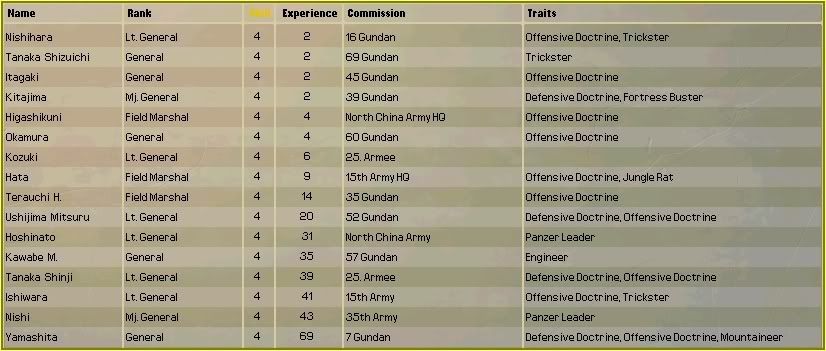
"Our current Commanders are farily experienced with the best including our two Army Commanders, Field Marshalls Higashikuni and Terauchi."

"Our most experienced ground forces are the three Armoured divisions led by Lt. General Hoshinata which form part of the defensive forces in Mukden. Our most experienced Infantry division is 40 Hoheishidan, commanded by lt. General Uchiyama, which has seen some fairly consistant action during its defence of Colombo. That is all from me and I will hand you over to Minster Jun for an Airforce briefing." concluded Satoru.
"Good morning your Majesty, Gentlemen." Jun began. "The Imperial Japanese Air Force has grown in size by five squadrons during the last year. All of these additions were Close Air Support squadrons."
"Good morning your Majesty, Gentlemen." Jun began. "The Imperial Japanese Air Force has grown in size by five squadrons during the last year. All of these additions were Close Air Support squadrons."

"The current strength is sixty two squadrons comprising of a large Interceptor force with an equal force of both Tactical and Dive bombers and a small force of Naval bombers. Our Allies forces have remained unchanged. We are planning to double our Tactical bomber force during the coming year. Most of our bombers are flying in support of operations in Asia as the Pacific has become very quiet."

"The most damaged squadrons are shown here and there are more with minor damage not listed. The almost continous need to attack enemy targets is giving little time for repairs and is slowly having a detremental effect on our airforce but nothing major at this time. You can also see that more Interceptors are due to complete upgrades fairly soon with some still requiring longer periods. Some squadrons in the Pacific have not begun the process of changing to Turbojet as they require the extra range to continue their patrols."
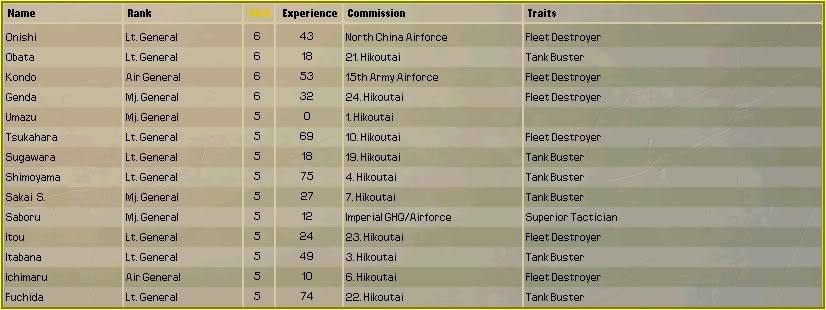
"The vast majority of our senior experienced pilots are with bomber wings which are in constant action. One notable exception is Mj. General Saboru who is in command of the Interceptor wing based at Ahmadabad."

"This list does not show all of our fully experienced squadrons which are all bomber squadrons. It does show our highest experienced Interceptor squadron , 77/78 Sentai based in Tokyo where it is undergoing upgrade. Mj. General Kato commands the air wing it is part of. I will hand you over to Minister Osami for the Naval briefing." concluded Jun.
"Thank you. Good morning your Majesty, Gentlemen. The Imperial Japanese Navy has routed its enemies over the past year or so and commands large parts of the Pacific and Indian Oceans. There remain some threats of which the United States Navy and its modern Carriers is the largest." Osami began.
"Thank you. Good morning your Majesty, Gentlemen. The Imperial Japanese Navy has routed its enemies over the past year or so and commands large parts of the Pacific and Indian Oceans. There remain some threats of which the United States Navy and its modern Carriers is the largest." Osami began.

"The list of ships sunk during the last month is short and does include two of our Submarine Flotillas. One other loss to note is the 14. Unterseebootsflottille which was flying American colours when it sank in Samoa. Apparently we were not the only Country to benefit from the demise of Germany."
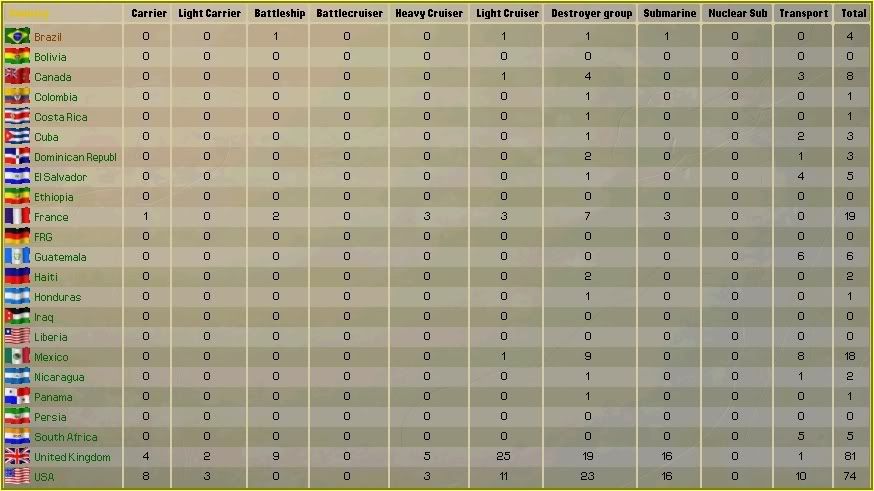
"When we captured Pearl Harbour and the other islands of Hawaii we found some documents which have since been deciphered and translated. The documents were of Brazilian origin and show the rough sizes of all Allied fleets at the end of June 1946.
If these numbers are correct then our intelligence estimates for the Royal Navy are off by some margin in regards to Battleships. A most interesting observation is the fact that the Royal Navy was the largest enemy fleet at the time where it eclipsed the United States Navy. Both are weaker than the Imperial Japanese Navy numbers wise. The entire Allied Navy only had forty one Transport Flotillas at the time which demonstrates the success we had in sinking their Merchant Marine in the Pacific and Indian oceans. There are also some surprises in which Nations control those Transport ships."
If these numbers are correct then our intelligence estimates for the Royal Navy are off by some margin in regards to Battleships. A most interesting observation is the fact that the Royal Navy was the largest enemy fleet at the time where it eclipsed the United States Navy. Both are weaker than the Imperial Japanese Navy numbers wise. The entire Allied Navy only had forty one Transport Flotillas at the time which demonstrates the success we had in sinking their Merchant Marine in the Pacific and Indian oceans. There are also some surprises in which Nations control those Transport ships."

"In January of 1946 the Imperial Japanese Navy comprised of 119 vessels and you can see it has grown by one. Both our Submarine and Heavy Cruiser fleets have shrunk due to losses with our Destroyer Flotillas growing in number as have our Light Carriers with two more due shortly.
Force deployments for our main fleets are as follows:
Carrier Group C - Colombo.
Carrier Group D - Colombo.
BB Division 1 - Supporting Operation Tedious.
BC Division 1 - Tokyo.
You will notice that BB Division 2 is no more and is replaced by BC Division 1 which Admiral Koga is Commanding. Both Carrier Groups contain three Aircraft Carriers. BB Division 1 has four Battleships with two undergoing repairs. IJN Yamato is its Flagship as IJN Yamashiro is badly damaged. The Battlecruiser IJN Kongo is the Flaghsip of BC Division 1 which will inherit both of the new Light Carriers and is likely to remain on guard duty around Japan until the new Battlecruisers arrive in August. BC Division 1 can replace BB Division 1 in support of Operation Tedious if required.
We still have three CA Divisions in the Pacific providing some protection to our central islands with no fleet currently protecting Hawaii as no enemy presence has been detected for quite some time."
Force deployments for our main fleets are as follows:
Carrier Group C - Colombo.
Carrier Group D - Colombo.
BB Division 1 - Supporting Operation Tedious.
BC Division 1 - Tokyo.
You will notice that BB Division 2 is no more and is replaced by BC Division 1 which Admiral Koga is Commanding. Both Carrier Groups contain three Aircraft Carriers. BB Division 1 has four Battleships with two undergoing repairs. IJN Yamato is its Flagship as IJN Yamashiro is badly damaged. The Battlecruiser IJN Kongo is the Flaghsip of BC Division 1 which will inherit both of the new Light Carriers and is likely to remain on guard duty around Japan until the new Battlecruisers arrive in August. BC Division 1 can replace BB Division 1 in support of Operation Tedious if required.
We still have three CA Divisions in the Pacific providing some protection to our central islands with no fleet currently protecting Hawaii as no enemy presence has been detected for quite some time."

"Damage is concentrated to a few ships with IJN Yamashiro being the most badly in need of repairs. Some ships will take months to complete repairs."
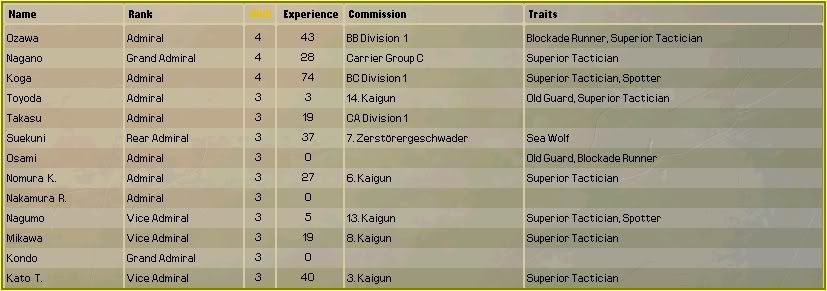
"Our Naval Commanders are not quite as experienced as their counterparts in the other branches of the Armed Forces as they see a lot less action. Our main fleets are Commanded by our most experienced commanders in Ozawa, Koga and myself, although I rarely command my own Carrier Group."

"IJN Chiyoda, a Light Carrier, has our most experienced crew and she is currently the Flagship of CA Division 4 based in the Fiji Islands under the command of Admiral Kogowa. No particular class of ship is dominant and there are no Battleships on the list as they have all lost crew during combat over the last year which diluted their experience."

"Total kills since June 1944 for all sides during Naval combat are shown here. These totals do not include losses to aircraft. The Imperial Japanese Navy has been responsible for sinking a massive amount of smaller ships as well as four Carriers and Battleships. The second line is also ours so we have a Japanese fleet responsible for 497 ships against an Allied fleet only sinking 73. This is one reason why we control the seas for the time being but there is another."

"Total ships sunk by Aircraft since June 1944. Japanese aircraft, primarily Naval bombers, have sunk over 50 enemy capital ships in two and a half years. They have also destroyed large amounts of smaller ships and have been ably supported in this task by Interceptor squadrons and Tactical bombers during our main Pacific offensive. Our Siamese puppet has jumped into second spot after some noteworthy successes.
Combining both sets of losses we arrive at 767 vessels or flotillas sunk by Japanese forces since June 1944. We had a total of 551 last January which means 216 during 1946 which is less than the total for 1945 of 317."
Combining both sets of losses we arrive at 767 vessels or flotillas sunk by Japanese forces since June 1944. We had a total of 551 last January which means 216 during 1946 which is less than the total for 1945 of 317."
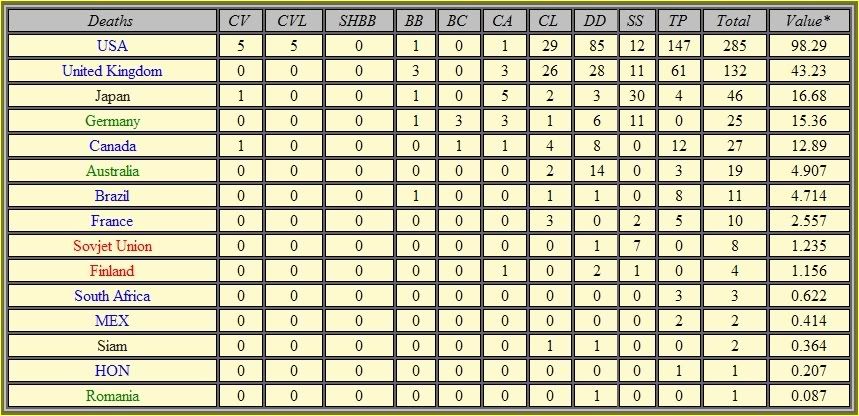
"Losses by Nation to sea combat since June 1944. The United States Navy is way ahead of everyone else on the tonnage of vessels lost purely in naval combat. Adding the losses by aircraft moves the margin even higher as the vast majority of ships sunk by our aircraft are also American."

"This list shows the most feared Battleships afloat and you will notice one name missing. Whilst the ships listed have been responsible for sinking 154 enemy ships the one name not on the list has been credited with 106, including one Aircraft Carrier and one Battleship. This is of course IJN Yamashiro."

"Our Aircraft Carriers have not been quite so effective with IJN Zuikaku overtaking last years leader IJN Junyo."

"Total convoy losses have increased from 312 to 397 mostly lost during the first half of 1946. Almost all were replaced before we stopped building these vessels. Escort losses have nearly doubled as they tried to protect their unarmed charges. We have sunk one additional convoy during 1946 but we have not really tried to conduct this type of warfare at all. That concludes my briefing and that of the Armed Forces." Osami concluded.
"Thank you Gentlemen. 1946 was a very good year for Japan despite the Soviet aggression, let us hope 1947 continues in the same vain as I am sure it will." stated Hirohito as he stood and left.
"Thank you Gentlemen. 1946 was a very good year for Japan despite the Soviet aggression, let us hope 1947 continues in the same vain as I am sure it will." stated Hirohito as he stood and left.



